NORTHBOUND SEVEN: BIRDS
Sky beckons, wings spread
a feather remains

The trip was not about birding specifically though we love seeing them. Lakes, rivers, wetlands, oceans, and forests, all presented winged friends. We did pre-plan several locations known as gathering places and were happily surprised at discovering others. Most sightings were random but we did keep a sharp look-out.
Note: I am aware that many of the following photos are not
best quality, but are included to illustrate the variety we encountered.
EAGLES, HERONS, AND CRANES
We
went to the Eagle Reserve in Haines, AK and saw them everywhere but there. We
went to the Great Blue Heron Nature Reserve shortly after crossing into Canada.
But we actually saw them in Skagway, AK. We missed the cranes in Fairbanks
previously, but caught them this year before they migrated.
Hanging
out at Dyea outside of Skagway was rewarding. The shoreline hosts the
scavengers like Eagles, Ravens and Gulls as well as waders.
Bald Eagle and Western Crow
One of our most exciting surprises was a bird we heard singing on our hike out to Yakutania Point between Skagway and Dyea.
We
couldn’t figure out what it was until we spotted the singer, a bald eagle! WOW!
Just below Anchorage, heading onto Kenai Peninsula, there is a wetland and wildlife corridor. A few years ago, it had been abandoned by all the critters due to smoke from raging fires.
We
were happy to visit Potter Marsh again. While we were busy looking at
waterbirds, there was an aerial show going on above us. Two adult Bald Eagles
monitoring their fledgling. It’s nice to know they nest at this refuge.
This one appears to be fully grown, but has not developed the adult plumage. He still has speckles and no white head as yet.
Stopping at a Cook Inlet beach on our way to Homer, there was an extravaganza of both Eagles and Gulls. An immature Bald Eagle feasting on salmon.
I'm always surprised when Eagles make use of the tallest structure around for a lookout, like this lamp post at the Prince Rupert ferry terminal, and, the cell tower on Kenai.
Part
of our learning curve were the iconic representations of the indigenous
cultures we came across. Clearly First Nations peoples were inspired by birds;
eagles, crows, and ravens particularly. (See Ch 10)
Gitanyow,
BC
An eagle
feeding its young, this modern chainsaw sculpture is at Miracle Beach
Campground, Vancouver Island.
Returning from a side trip while at Goldstream campground, a large bird swooped low over the truck. We stopped and got out to find him sitting just above us, a splendidly speckled immature Baldy. To this day, we can still feel the swoosh.
From
one of our last campgrounds of the trip, we hiked down to Dungeness Spit. I
happened to catch this Bald. He belongs to the forest.
HERONS
Early in the trip, we chose a campground close to the Heron reserve in Chilliwack, BC. Unfortunately, we did not see them at the time of day we visited, but we could hear the nesting birds in the trees, behind the scenes. They had gone out to feed in the early morning and were back with their chicks until evening when they would fly out to feed again.
For
us, it turned into a nice uneventful walk through the grounds. It is a popular
bike trail for locals as well. It was cool to see the protected living
arrangements.
We
were familiar with herons nesting from Klamath Basin Refuge in Oregon, so it
was easy to imagine them tending their enormous nests.
At
Dyea, near Skagway, the mouth of the Taiya River becomes an estuary before
entering the North Pacific. Its many streams are salmon runs and wading birds
comb the beach and shallows. Several Great Blue Herons made an appearance.
Great Blue Herons and Sandhill Cranes are large birds, both over three feet tall. The heron is a little larger with longer legs and neck and a heavier bill. Like all herons, they have the classic S shaped neck to let their heavy head rest on the body – as seen in flying.
CRANES
The
large Cranes are heavier bodied with a longer wing span and fly with their
necks out straight.
Creamers Field in Fairbanks, AK was once a dairy but has become a Migratory Waterfowl Refuge operated by the state. The 1800 acres of open land, grasses, forest, and wetland, are appealing to many varieties of migrating birds as well as Sandhill Cranes that nest here each year. On a previous trip, we had missed both the migrating and nesting birds by a week; it was virtually empty. This time we made it before they left.
Lots
of time is spent preening their feathers.
Our campground was very close-by so we visited at different times of the day over several days. The juvenile cranes, called colts, were nearly full grown but still bearing their rusty red feathers. We followed one family for at least thirty minutes; them in the field and us on a path inside the tree line.
The parents were ever vigilant as they moved along and/or stopped to snack.
We had seen the cranes, and heard their unmistakable raucous calls at both coastal Homer and at Glenallen, in the interior, most likely migrating from the tundra where they had nested for the summer.
GEESE AND SWANS
From
the beginning of the trip to the end, we enjoyed seeing Canada Geese. They are
truly iconic and it was nice to view them in their home environment.
At the
reserve in Fairbanks, Canada Geese mingled freely with all the other birds.

With
their goslings, they remind us of the smaller Hawaiian Goose at home, the Nene.
(taken in the Rockies)
Qualicum Beach, Vancouver Island on our way back down.
New to us were the Greater White Fronted Geese that also breed in the arctic tundra. The first four are adults with fully developed white on their faces. The last two, at left, are maturing in stages.
Note relative size between these large juvenile geese to the mature female Mallard
duck.
The white face development is well under way on this handsome specimen.
We had
seen this great diorama (Beaver Creek Visitor Centre, Yukon) featuring
Trumpeter Swans nesting. We did not see the secretive pair that reportedly live nearby.
Trumpeter
Swans (the largest variety) are no longer facing extinction. We were lucky
enough to encounter them in the wild. Entering Kenai Peninsula, we saw a couple
but could not stop for pictures.
This
group was at the fresh water Lagoon in Seward. Fun to see them preen and
stretch legs and wings. They shared the bank with gulls, ducks, and ravens
while spawning salmon swarmed.
Vegetarians;
they dabble for greens.
We saw
this swan on different parts of the lake each time we walked the trail around
it; likely her nesting territory seriously guarded. Wander Lake, Fairbanks.
GULLS
AND SANDPIPERS
Where there is water, there are gulls. They are soaring shore birds from fresh to brackish to salt water. They are so common it is easy to overlook them.
But,
trying to identify the ones we saw in the North was a challenge. Their
appearance varies from youth to maturity and from season to season. They also
hybridize, so maybe getting the correct ID isn’t all that critical to them
either.
GLAUCUS
WINGED GULLS
He's
very interested in the dead salmon (while the napping Mallard behind him could
care less), Potter Marsh, Kenai.
There are dead salmon on the bank here as well. Lagoon at Seward, AK
Not sure what suddenly caught his interest.
More than two dozen in one small section of beach. Cook Inlet, Kenai
Gulls and Bald Eagles; both scavengers, they share the sky and share the beach.
Immature
gulls are well camouflaged at rest. The pylons above serve as nesting
platforms.
Adventurous
juveniles at Homer. Honing their skills, they seem to enjoy landing on rocks
protruding above changing tide (a Bald Eagle had been on this rock earlier when
it was more exposed).
MEW
GULLS
Adult
Mew Gull, Seward, AK
Immature
Mew minding his own business, Cook Inlet
BONAPARTE'S GULLS
One of
several at Wye Lake, Yukon
Adult Bonaparte's lose much of the black on their heads in winter and look somewhat
like juveniles. In this salmon run at Fish Creek, AK, they will feast on the
fish eggs.
Hundreds of gulls, a mixture of mature and immature, including Bonaparte's sat on this spit at Miracle Beach, Vancouver Island. When a small seaplane took off, they did too.
Nearby we saw this character beautifully landing.
BLACK
LEGGED KITTIWAKES
Homer
Spit, Kenai
Kittiwake chicks are well camouflaged in the rocks.
SANDPIPERS
We saw
a few Sandpipers, both rock-shorebirds and waders. The camouflage of the rock
birds always gets my attention and I realize how many I probably missed.
Cute
little five-incher with a name longer than he is, at the mouth of the glacial
Salmon River, Hyder, AK.
Semipalmated
Sandpiper
This
might be a Dunlin with that curved bill. They don’t sit still for study. Skeena
River, at ‘Ksan, BC.
Greater
Yellowlegs are larger sandpipers; waders. We saw them at Dyea near Skagway, and
at Potter Marsh on Kenai.
Even zoomed to the max, it was like a Where’s Waldo in the harsh mid-day light. Dyea, AK
Greater Yellowlegs at Potter Marsh; likely a breeding pair.
PUFFINS
Probably
the most exciting new bird experience was finding so many Puffins on our marine
tour out of Valdez, AK. Some years ago, I looked into volunteering on Bird
Island off the coast of Wales where Puffins nest, but it did not happen.
This
was extraordinary, but not just for me. The boat captain said he’d never seen
so many and never with both varieties present!
Tufted
Puffins
It was soooo cold on the outer deck, jostling with other excited nature lovers! This was photo of the year for me, love the reflections on the glassy water.
Behind these Grebes on Haida Gwaii, are three little Ancient Murrelets. Murrelets are in the same Alcid group as Puffins. (We had also seen one on the marine tour that really got the captain excited).
This is a Marbled
Murrelet swimming solo off-shore at Seward.
LOONS,
GREBES, AND DUCKS
There is absolutely nothing like the call of the LOON. We would often hear them even as we slept, and smiled. Elusive in viewing, they dip under the water quickly and can stay down for five minutes chasing their prey (fish and crustaceans). It is impossible to guess where they will come up next.
We we
saw this Loon out on the lake; so grateful when he popped up closer to us minutes
later. Paul Lake Provincial Park, BC.
At Jasper we saw the only family of loons. At 8:30pm they were safely obscured by the raking twilight.
A Common Loon pair greeted us at our first stay at
Kinaskan Lake Provincial Park. We were very disappointed when they did not
visit on our return stay there. Stunning creatures, very territorial, this
would likely be the only pair on the enormous lake.
At
Gitanyow, BC
GREBES
are in a class of their own, like the Loons. And like the Loons, they are
carnivores that eat small aquatic animals. The Red-Necked Grebe is considered
uncommon but it is mainly what we saw. (See Grebes with the Murrelets at Haida Gwaii above).
Wye
Lake, Yukon
Mirror
Lake, North of Anchorage. I had just missed a shot of an Arctic Loon (the only
one we saw) when this guy popped up.
It was
very hard to track down what this little chick was. Swimming near the swan at
Wander Lake in Fairbanks, we knew he was not a cygnet. We finally caught on
that the young Grebes have striped faces.
By the time we saw this older version, also at Wander Lake, we had figured it out. The red throat plumage is coming in but the face still has stripes.
DUCKS are common to ponds and marshes. Primarily vegetarians that dabble below the water surface for their food, they might eat aquatic proteins during breeding. Both the Mallard and Pintail ducks have a wide range and are often found together.
Potter
Marsh, covering several hundred acres, is part of the Anchorage Wildlife
Refuge with a 1500 foot boardwalk. Well out of the city, it connects with Turnagain Arm on Kenai Peninsula.
Perhaps a sleek Northern Pintail behind the Mallards; hard to note markings when silhouetted like this.
Classic Mallard hen. While any number of ducks are in the mottled brown category,
she is showing off her pretty blue speculum with dramatic black and white
borders.
Mallard
Drakes (males) with their distinctive dark green heads, Rockies.
Cranberry
Marsh, BC (inland rainforest) provided us with many fleeting sightings.
Mallard
hens on the bank, an American Coot in the water.
A
Mallard Drake following a Blue Winged Teal, both possibly molting.
Mallards,
with a few geese in the middle, a drake in lower right corner. Fairbanks AK
Below,
mature and immature Mallards. The larger one in back is a Drake that has
reached breeding age (and possibly the one in the grass), the others are
visibly younger and have not yet reached the "eclipse" stage. Lower
left corner is a Northern Pintail, sleek with a longer neck.
American
Widgeons, peacefully napping. Wander Lake Fairbanks.
The
female American Widgeon is, at first, similar to the other mottled female
ducks, but the white bill defines her.
Birds
we had never seen before were often baffling to identify even with charts and
pamphlets. This is a Ring-necked duck where the obvious ring is on the bill and
barely visible at the neck!
At
Fish Creek, AK (where we were too early for the bears), someone had seen two
beavers in this part of the creek. No beavers for us but we saw these Common
Mergansers. Fresh-water ducks, their crest is not particularly obvious here.
The
Red-Breasted Mergansers, however, are salt-water ducks and we enjoyed watching
them at Miracle Beach, Vancouver Island.
Their
crests are more exaggerated and were clearly visible, as were their antics.
Ducking and diving for snacks, all females, some with more showy white
markings.
Suddenly harassed by a harbor seal that had been lurking nearby, they beat the surface for take-off.
Also
at Miracle Beach, I caught this raft of birds I had a devil of a time
identifying. They are female Harlequin Ducks. Without the dramatic feathering
of the males, it was down to the white markings on their heads. These are
salt-water or sea ducks.
CORVIDS
– Ravens, Crows, Magpies, and Jays
Crows and Ravens range over North America, Crows not venturing quite as far North. They tend to be carrion feeders and like heavy timber so the majority of our Corvid friends were Ravens spotted on our forested road trip to the North.
The
Common Raven, the largest at 21 inches, is considered a songbird. We
got to experience that this year. This beauty treated us to his song for
several minutes, BC.
Another
gorgeous Raven, curiously checking out the cars at the Yukon border.
The
Common Crow. This group appeared to be having a confab at our campground at
‘Ksan, BC.
The
totems at nearby Gitanyow represented many birds. Crows and Ravens are critical
to native teachings (see Ch 10).
Note: Of course First Nations had their own words for
wildlife familiar to them but visiting Europeans were sometimes mistaken in their naming. Today, some groups have their clan totems misnamed as crow when
they are actually ravens. Ironically, this occurred in Hawaii as well, the
so-called native crow is actually a small raven (now extinct in the the wild).
The Black-billed Magpie is nearly as large as the Raven with a splendid long tail, BC.
The
Northwestern Crow is likely what we saw scavenging along coastlines with Eagles
on Cook Inlet, Kenai and at Dyea near Skagway. They are smaller than the Common
Crow and the coastline is their territory.
We
watched several hopping around the rocks at the Seward, AK waterfront.
Half the size of a raven, the Gray Jay is prevalent through the Rockies, Canada and Alaska. (We called these camp-robbers in Colorado.) Near Jasper, in the rain.
RANDOM
OTHER BIRDS
The
most common forest birds we saw were robins and I didn’t photograph them, just
enjoyed their hopping around, tending to business.
Spruce
Grouse, we saw many of these scurrying, but only caught this one on camera near
Watson Lake, Yukon.
Pileated
Wood Pecker. There were several of these unique characters pecking the ground
at a nearby campsite in Miracle Beach, BC. I couldn't tell what they were
feeding on. (These guys pose a real pest-problem for our family in Oregon.)
At the
beautiful Cranberry Marsh in BC, we caught two beauties in addition to all the
waterbirds.
Cedar Waxwing
We
mistook this for a Red-winged Blackbird until zooming in. Tri-colored
Blackbird.
The
stunning mural in Old Masset on Haida Gwaii.
Left top to bottom:
Eagle,
Harlequin Duck, Rufus Hummingbird
Right top to bottom:
Raven,
Great Blue Heron, Trumpeter Swan, Sandhill Crane
Acknowledgements follow Chapter 10, however, special thanks to Kim Uyehara, wildlife biologist and wetland expert, for an overview of bird identification. Errors are all mine.










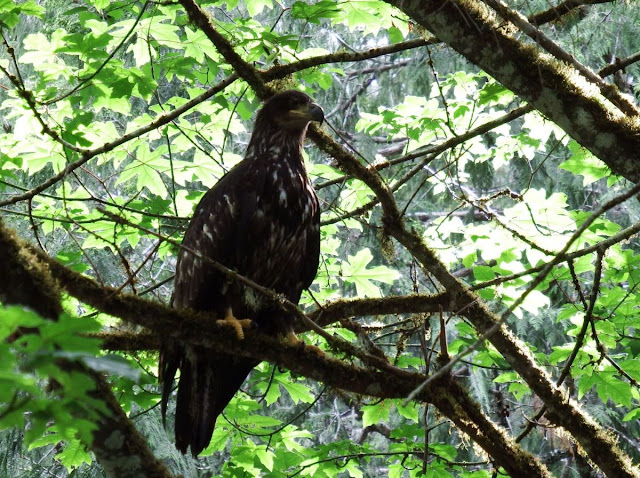


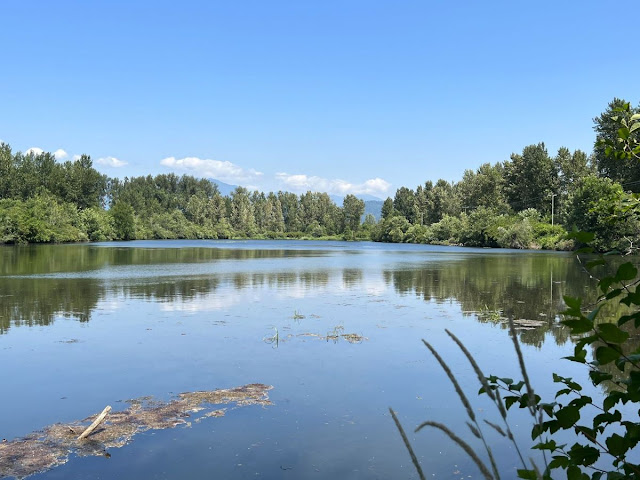









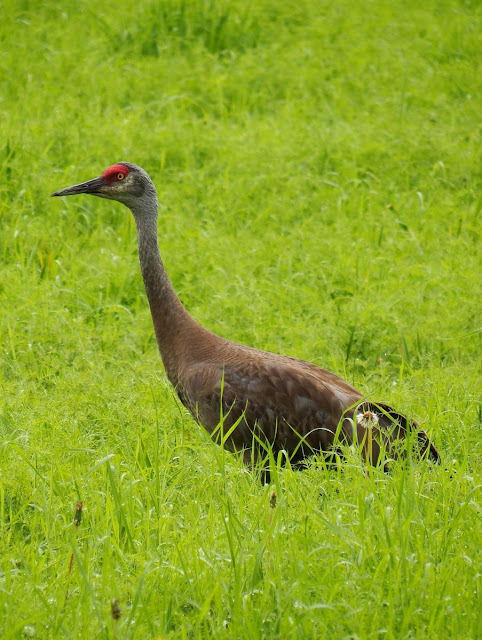



















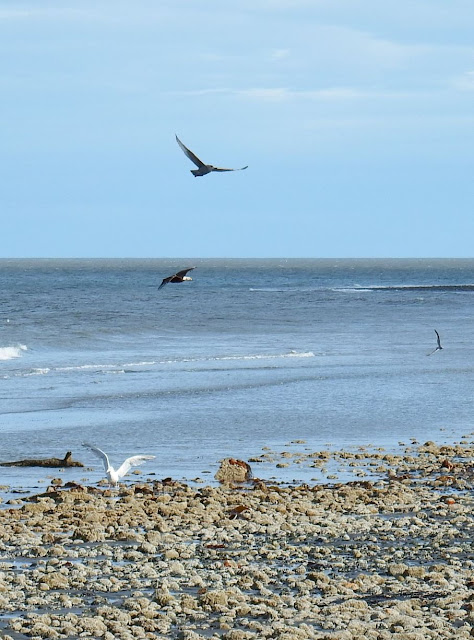




















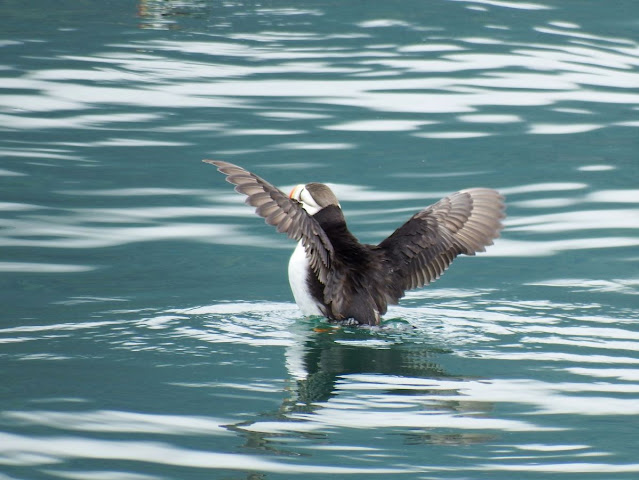


















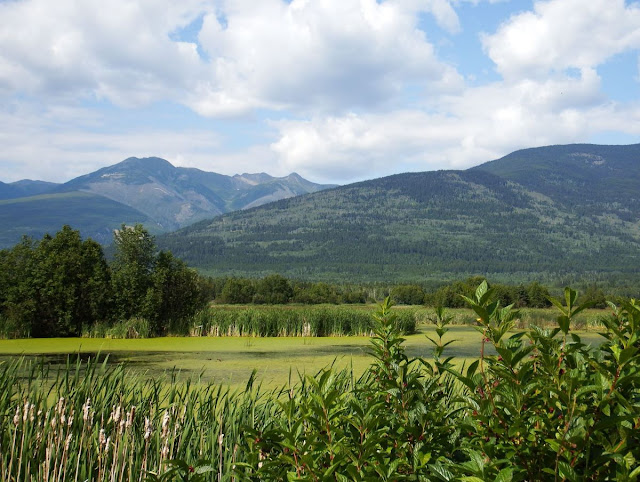







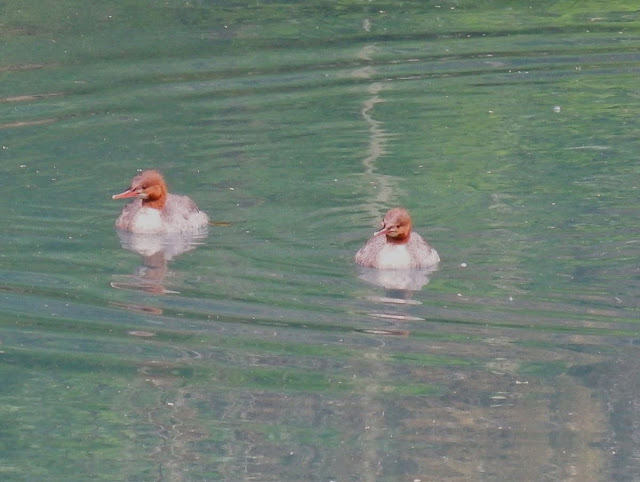















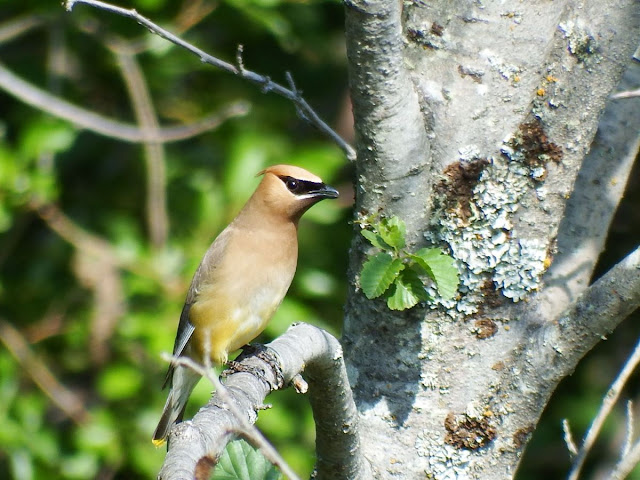





Comments
Post a Comment